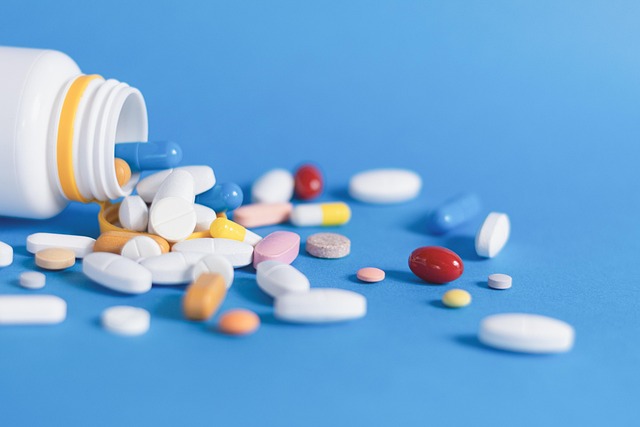GLP-1 receptor agonists (GLP-1 drugs) are innovative medications that mimic natural hormones to manage blood sugar levels effectively in type 2 diabetes. They stimulate insulin production, suppress glucagon secretion, and offer additional benefits like weight loss and reduced cardiovascular risks, making them a popular choice for diabetes care. These drugs also show promise in treating obesity and have cardiovascular advantages, but they can cause gastrointestinal disturbances and hypoglycemia, requiring regular blood sugar monitoring. Future research aims to expand their use beyond glycemic control, exploring neuroprotective properties and tailored treatments for improved patient well-being.
“GLP-1 receptor agonists, a class of innovative diabetes medications, have emerged as powerful tools in managing blood sugar levels. This article delves into the intricate mechanism of action of these GLP-1 drugs, exploring their role in regulating insulin and glucose. We’ll dissect how these agonists interact with the body’s natural systems, focusing on their effects on blood sugar control, weight management, and cardiovascular health. Additionally, we’ll discuss side effects, current research, and future prospects for this promising treatment.”
What are GLP-1 Receptor Agonists?

GLP-1 receptor agonists are a class of medications designed to mimic the effects of the natural hormone glucagon-like peptide-1 (GLP-1). These drugs play a crucial role in managing blood sugar levels, primarily used in the treatment of type 2 diabetes. By activating GLP-1 receptors in the body, they stimulate insulin production and suppress glucagon secretion, leading to improved glycemic control.
GLP-1 drugs have revolutionized diabetes care with their dual action: enhancing insulin release when blood glucose is high and reducing it when levels are low. This mechanism helps maintain stable blood sugar, making them effective in improving metabolic health and potentially lowering the risk of diabetic complications. Their increasing popularity stems from their ability to provide better glycemic control compared to traditional medications while offering additional benefits like weight loss and reduced cardiovascular risks.
How Do They Interact with the Body?

GLP-1 receptor agonists interact with the body by mimicking the effects of the natural hormone glucagon-like peptide-1 (GLP-1). These drugs bind to specific receptors on the surface of cells, primarily in the gut and pancreas. This binding triggers a cascade of cellular responses that ultimately lower blood sugar levels.
In the context of diabetes management, GLP-1 drugs stimulate insulin secretion from the pancreas in response to rising blood glucose, while also slowing gastric emptying, which helps to improve glycemic control. Additionally, they can reduce appetite and slow food digestion, leading to decreased calorie intake and weight loss, making them a valuable tool in treating both type 2 diabetes and obesity.
Mechanisms of Blood Sugar Control

GLP-1 receptor agonists, a class of drugs designed to mimic the effects of the natural hormone GLP-1 (glucagon-like peptide-1), play a crucial role in blood sugar control. These drugs primarily act by enhancing insulin secretion from the pancreas in response to rising blood glucose levels, particularly after meals. This effect is achieved through their interaction with specific receptors on beta cells, leading to increased insulin release.
In addition to stimulating insulin production, GLP-1 drugs also inhibit glucagon secretion, a hormone that raises blood sugar. By blocking glucagon’s actions, these agonists help reduce liver glucose output, further contributing to better blood sugar regulation. This dual mechanism of action makes GLP-1 drugs effective in treating type 2 diabetes by not only lowering blood glucose levels but also helping to stabilize them throughout the day.
Role in Weight Management

GLP-1 receptor agonists play a significant role in weight management, making them a key class of drugs in the fight against obesity. These medications mimic the effects of the natural hormone glucagon-like peptide-1 (GLP-1), which is secreted in response to food intake. By activating GLP-1 receptors, these agonists stimulate feelings of fullness and reduce appetite, leading to decreased calorie consumption.
Additionally, they slow down gastric emptying, causing a sense of satiety that lasts longer. This dual action helps individuals make healthier food choices and maintain a reduced calorie intake. As a result, GLP-1 drugs have been shown to promote significant weight loss in clinical trials, making them valuable tools for managing obesity and its associated health risks.
Cardiovascular Benefits

GLP-1 receptor agonists, or GLP-1 drugs, offer significant cardiovascular benefits that have been well-documented in clinical trials. By mimicking the effects of the natural hormone glucagon-like peptide-1, these drugs lower blood pressure through vasodilation and reduce heart rate. This dual action mitigates the risk of cardiovascular events, a leading cause of mortality worldwide.
Additionally, GLP-1 drugs improve endothelial function, promoting better blood flow and vessel health. They also exhibit anti-inflammatory properties, reducing inflammation in the cardiovascular system. These beneficial effects contribute to the overall improved heart health observed in patients taking GLP-1 receptor agonists, making them a valuable tool in managing and preventing cardiovascular diseases.
Common Side Effects and Considerations

GLP-1 receptor agonists, while generally well-tolerated, can cause several side effects. The most common include nausea, vomiting, diarrhea, and stomach pain—often referred to as gastrointestinal disturbances. These symptoms are usually mild and tend to diminish over time as the body adjusts to the medication. Another consideration is the potential for hypoglycemia, particularly in individuals with type 2 diabetes who may also be taking other glucose-lowering drugs. GLP-1 drugs can also lead to changes in appetite and weight, with some patients experiencing reduced hunger and subsequent weight loss.
Important factors to keep in mind include regular monitoring of blood sugar levels, especially for those with diabetes, and seeking medical advice if side effects are severe or persist. Adjustments to medication doses or types may be necessary, but continuing use is often recommended due to the potential long-term benefits.
Future Prospects and Research

The future prospects for GLP-1 receptor agonists are promising, with ongoing research exploring their potential beyond blood glucose control in diabetes management. Studies are investigating the role of these drugs in cardiovascular health and weight management, aiming to reduce the risk of heart disease and promote sustainable weight loss. Additionally, scientists are delving into the neuroprotective effects of GLP-1, suggesting a possible link to improved brain function and cognitive health. As research progresses, we can anticipate more specialized GLP-1 drugs tailored to individual patient needs, further enhancing their therapeutic benefits. This ongoing exploration highlights the significance of GLP-1 receptor agonists in revolutionizing diabetes treatment and improving overall patient well-being.
